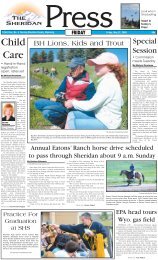Ex-guard member plans to sue state - The Sheridan Press
Ex-guard member plans to sue state - The Sheridan Press
Ex-guard member plans to sue state - The Sheridan Press
You also want an ePaper? Increase the reach of your titles
YUMPU automatically turns print PDFs into web optimized ePapers that Google loves.
Outdoors Outdoors<br />
Season<br />
for<br />
hunting<br />
Mule deer, elk hunters<br />
meet with success as<br />
seasons open<br />
By Patrick J. Murphy<br />
Sports Edi<strong>to</strong>r<br />
Hunting seasons in the <strong>Sheridan</strong> area went off <strong>to</strong> a<br />
good start with the opening of a majority of mule deer and<br />
elk hunting areas opening Oct. 15.<br />
Area Wyoming Game and Fish personnel had check<br />
stations for hunters near Kaycee, Buffalo and Day<strong>to</strong>n.<br />
“For the number of animals, it looks like in Day<strong>to</strong>n<br />
probably there were 180 big game animals (checked),<br />
Black Hills deer,<br />
turkey hunters<br />
should note regs<br />
before heading out<br />
SUNDANCE — Black Hills deer hunters are alerted <strong>to</strong> regulation<br />
changes for 1999 in hunt areas 1-6.<br />
For the Nov. 1-20 season, deer hunters are restricted <strong>to</strong> antlered<br />
deer on public land and any deer only on private land. In previous<br />
years, hunters were allowed <strong>to</strong> harvest any deer on public lands other<br />
than national forest land.<br />
“In previous years, the public land other than national forest land<br />
was sustaining a substantial amount of harvest of does and fawns,”<br />
said Sundance game warden Chris Teter. “With the depressed deer<br />
population in the Black Hills, this was not helping our goal of building<br />
the herd.”<br />
<strong>The</strong> public land receiving heavy doe/fawn harvest in 1998 included<br />
Bureau of Land Management land north of Devils Tower,<br />
Thunder Basin National Grassland near Up<strong>to</strong>n, <strong>state</strong> land near<br />
Beulah and the Sand Creek Wildlife Area.<br />
Teter added that this season is a bit more conservative in response<br />
<strong>to</strong> low deer numbers. “<strong>The</strong> 1999 season will protect more does and<br />
fawns while giving landowners latitude <strong>to</strong> control damage situations<br />
if they choose,” he said.<br />
Hunters are also reminded that the closing day for deer season in<br />
hunt areas 1-6 and turkey hunt area 1 is Nov. 20.<br />
<strong>The</strong> G&F urges all hunters <strong>to</strong> read the 1999 hunting regulations<br />
before heading <strong>to</strong> the field this fall.<br />
“Many people from across Wyoming travel <strong>to</strong> the Black Hills <strong>to</strong><br />
hunt deer and turkeys in November,” Teter said. “Those planning on<br />
hunting the Black Hills in November this year should be aware the<br />
seasons close before Thanksgiving again this year.”<br />
Turkey populations in the Black Hills have recovered following<br />
three years of good reproduction.<br />
<strong>The</strong> G&F opened the turkey season this fall in hunt area 1 on Oct.<br />
15 and it will close on Nov. 20 <strong>to</strong> coincide with deer season closing.<br />
Hunters are also reminded that antelope season will also close<br />
Nov. 20 in hunt areas 1-5.<br />
<strong>The</strong> <strong>Sheridan</strong> <strong>Press</strong>, Thursday, Oc<strong>to</strong>ber 21, 1999<br />
mostly deer and some elk,” said Lynn Jahnke, regional wildlife management<br />
coordina<strong>to</strong>r with the Wyoming Game and Fish Department based in <strong>Sheridan</strong>.<br />
Near 400 animals were checked through the Buffalo station, and in Kaycee<br />
just under 250.<br />
Check stations were run at Kaycee for the first three days of the season,<br />
Sunday and Monday at the Buffalo check station and Friday afternoon and<br />
Saturday through Monday near Day<strong>to</strong>n.<br />
“Down in the south end, Kaycee area hunters are doing really well on<br />
deer,” Jahnke said. “Some elk are coming off there, if they are able <strong>to</strong> get on<br />
places where there are elk.”<br />
Those who hunted in areas on the west side of the Big Horns near Ten<br />
Sleep are “doing well on elk and deer,” Jahnke said. “On the east side near<br />
Buffalo, some hunters were doing fairly well on elk. We did see some very<br />
nice, mature bulls coming through the Buffalo check station.”<br />
Based on the number of of animals checked near Day<strong>to</strong>n, G&F personnel<br />
estimate the elk season is off <strong>to</strong> a slow start, as well as deer hunting in the Big<br />
Horns.<br />
“We did see come elk, but not a lot,” Jahnke said. “<strong>The</strong> deer harvest is<br />
somewhat slow on the mountain. Once we get snows<strong>to</strong>rms up on the mountain,<br />
we have less harvest of deer.”<br />
As for hearing complaints from hunters, Jahnke said, “Hunters seemed <strong>to</strong><br />
be fairly pleased with the season.”<br />
Hunters who get out year in and year out said they “are seeing a comeback<br />
of many of the game populations,” Jahnke noted. “Overall, the condition of<br />
the animals was pretty good, with good amounts of fat and the animals seem<br />
<strong>to</strong> be in good shape.”<br />
Few citations were handed out at the check stations.<br />
“We had very few violations, so compliance was really good. We are glad<br />
<strong>to</strong> see that,” Jahnke said.<br />
G&F personnel had volunteer help at the check stations. Among those volunteers<br />
were <strong>Sheridan</strong> College students who participated as part of school<br />
classes.<br />
“<strong>The</strong> added help was a real benefit for getting folks checked through the<br />
stations quickly,” Jahnke said.<br />
<strong>The</strong> weather, i.e. snow or rain, has not been a major fac<strong>to</strong>r yet in hunting.<br />
“<strong>The</strong> weather hasn’t been <strong>to</strong>o bad,” Jahnke said. “<strong>The</strong> first day (Oct. 15)<br />
was a pretty good day and there was a little bit of snow that evening, which in<br />
some cases helped hunters the second day. Now, it is turning out <strong>to</strong> be good<br />
again. Hunters are able <strong>to</strong> get around pretty well.”<br />
Who Can YOU Rely On?<br />
• Advanced Digital<br />
Document System<br />
• Digital Copier, printer &<br />
scanning capabilities<br />
• Quality & Competence<br />
in networking<br />
Linking Digital Technologies<br />
TODAY & TOMORROW<br />
674-7465<br />
124 South Main St.<br />
<strong>Sheridan</strong>, Wy.<br />
16 B<br />
CHECK IT OUT — Wyoming Game and Fish Department wildlife biologist<br />
Tim Thomas inspects an elk at a hunter check station. G&F personnel<br />
report hunters are seeing a comeback of many big game populations.<br />
Attention Hunters...<br />
Set Your Sights On <strong>The</strong>se Prices!<br />
TAKE AIM<br />
ON THIS<br />
SALE!<br />
Wyoming Game and Fish Dept. pho<strong>to</strong><br />
Unusual house guest for Green River couple<br />
GREEN RIVER — Green River residents Richard and Bobbie Ea<strong>to</strong>n<br />
had an unusual house guest Sept. 16.<br />
Wyoming Game and Fish Department wildlife investiga<strong>to</strong>r Scott<br />
Browning received a call that the Ea<strong>to</strong>ns had a deer in their house.<br />
Realizing he might need some help capturing the deer, Browning enlisted<br />
the help of Wildlife Supervisor Steve DeCecco and Wildlife<br />
Coordina<strong>to</strong>r Bill Rudd.<br />
<strong>The</strong> Ea<strong>to</strong>ns had been expecting a furniture delivery so they left their<br />
front door open. Unbeknownst <strong>to</strong> them a fawn deer was hit by a vehicle in<br />
front of their house on East Te<strong>to</strong>n Blvd. After getting hit, the fawn ran<br />
straight through the Ea<strong>to</strong>n’s front door and down the stairs.<br />
Bobbie Ea<strong>to</strong>n said that she had been standing by the stairway and felt<br />
something hit her leg and then saw something at the bot<strong>to</strong>m of the stairs. “I<br />
initially thought that it was a dog and then quickly realized it was a deer,”<br />
she said. Her husband went down the stairs after the fawn and it ran in<strong>to</strong> a<br />
basement room.<br />
“Now the s<strong>to</strong>ry really gets strange,” according <strong>to</strong> Browning.<br />
<strong>The</strong> Ea<strong>to</strong>ns have a floor-<strong>to</strong>-ceiling wallpaper scene of a deciduous forest<br />
in fall foliage. A small group of deer is pictured standing underneath the<br />
trees. When the G&F guys arrived, the fawn was at the back of the room<br />
standing next <strong>to</strong> the deer on the wallpaper.<br />
“I guess it felt at home,” said Browning. “Even though the deer were<br />
made of paper, it all looked quite serene and peaceful.”<br />
<strong>The</strong> G&F crew gently grabbed the fawn, <strong>to</strong>ok it out of the house and<br />
released it nearby.<br />
<strong>The</strong> fawn did not appear <strong>to</strong> have been injured from either being hit by<br />
the vehicle or the trip down the stairs. <strong>The</strong> fawn was last seen heading at a<br />
fast trot <strong>to</strong>ward where the mother had last been seen.<br />
UW student helps tribe track mountain lions<br />
IGNACIO, Colo. (AP) — Mountain lions may be one of the most feared and<br />
elusive preda<strong>to</strong>rs of Southwest Colorado, but a crew of scientists on the<br />
Southern Ute Indian Reservation has been persistently searching for the wildcats<br />
since January.<br />
<strong>The</strong> tribe is studying the dynamics of the mountain lion population on the<br />
reservation <strong>to</strong> develop a management plan that will determine if the population<br />
can sustain a hunting season, and if so, what the harvest limit should be and<br />
when the season should take place, according <strong>to</strong> Joe Koloski, a graduate student<br />
from the University of Wyoming, who is heading the study.<br />
<strong>The</strong> reservation was opened <strong>to</strong> mountain lion hunting in 1992, but was<br />
closed following the 1997 winter season, Koloski said. Non-tribal <strong>member</strong>s<br />
killed 18 mountain lions on the reservation during the 1992 and 1993 hunting<br />
seasons. After 1993, only tribal <strong>member</strong>s were allowed <strong>to</strong> hunt the cats, he said.<br />
Tribal <strong>member</strong>s were killing an average of two lions per year, according <strong>to</strong><br />
Terry Stroh, the head of the tribe’s Division of Wildlife Resource Management.<br />
Koloski said the level of harvest caused some concern within the wildlife<br />
department, because it wasn’t known if such hunting was sustainable.<br />
‘‘<strong>The</strong>y didn’t really know what they were doing <strong>to</strong> the population,’’ he said.<br />
<strong>The</strong> tribe then initiated the study <strong>to</strong> determine the population density of lions<br />
on the reservation, which covers 681,306 square acres.<br />
Stroh said he does not know how much the study is costing.<br />
Other goals of the study are <strong>to</strong> determine the mountain lions’ pattern of<br />
reproduction and the survival rates of adult mountain lions, Koloski said.<br />
To track a mountain lion, the crew first drives slowly through the reservation’s<br />
back roads, looking for tracks. <strong>The</strong>n, they use specially trained hound<br />
dogs <strong>to</strong> pick up the lion’s scent and chase it down.<br />
Koloski said it is much easier <strong>to</strong> track animals when there is snow on the<br />
ground, because the tracks are more visible and the snow holds a scent better.<br />
Once the dogs catch a lion’s scent, it normally doesn’t take them long <strong>to</strong> chase<br />
the lion up a tree, Koloski said.<br />
<strong>The</strong> crew then shoots the lion with an immobilizing dart and ties the dogs<br />
back <strong>to</strong> allow the lion an escape route. Lions that have been shot normally don’t<br />
feel comfortable in the tree anymore, Koloski said, so they take advantage of<br />
their escape route and leave.<br />
Within about 10 minutes of being shot by the dart, however, the lion’s muscles<br />
relax beyond use and an anesthetic makes them go unconscious, Koloski<br />
said.<br />
After the lion passes out, the crew has about two hours <strong>to</strong> go about their<br />
work. While the lion is unconscious, they harness it with a radio collar, tag its<br />
ear, tat<strong>to</strong>o its inner lip with an identification number, estimate its age and record<br />
general observations on its health and reproductive status, Koloski said.<br />
Once an animal is collared, the crew can locate its position on weekly flights<br />
over the reservation and bordering areas. Each collar has a different radio signal<br />
distinguishing it from the other collared cats.<br />
Since January, the mountain lion crew, made up of Koloski, the tribe’s<br />
wildlife biologist Sam Diswood, two full-time wildlife technicians and bison<br />
manager Chris Olguin, has tagged eight mountain lions.<br />
Of the tagged lions, there are three adult females, one adult male, three subadult<br />
females and one sub-adult male. Lions under 4 years old are characterized<br />
as sub-adults, Koloski said.<br />
Three of the adult female cats have had kittens, although the crew has only<br />
been able <strong>to</strong> locate and view two of the litters. <strong>The</strong> crew does not tag the kittens.<br />
‘‘Our goal is put out around 20 collars,’’ Koloski said. ‘‘We’ll continue with<br />
our capture effort throughout the winter and hopefully get that done.’’<br />
ASSORTED SELECTION OF 12-PK<br />
COKE COK<br />
PRODUCTS ONLY...<br />
$ 2. 7$ 92 . 79<br />
(NO LIMIT)
















